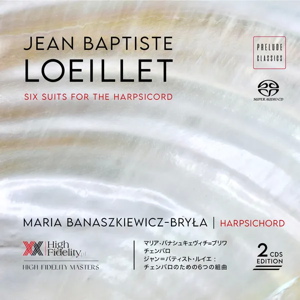
Jean Baptiste Loeillet (1680-1730)
Six Suites for Harpsichord (publ. 1723)
Maria Banaszkiewicz-Bryła (harpsichord)
rec. 2023, Villa at 3 Henryka Wieniawskiego Street, Poznań, Poland
Prelude Classics SACD PCL2400701 [2 discs: 110]
These are the Six Suites (or ‘Suits’) of Jean Baptiste Loeillet, which are not to be confused with those of his cousin, Jean Baptiste Loeillet de Ghent, nor indeed any other of the many similarly-named members of the Loeillet clan. Flanders-born Jean Baptiste Loeillet moved to London around 1705, after studies in Ghent and Paris, when he was 25 or so, and thereafter became popularly known as ‘John Loeillet of London’.
The Suites are termed ‘lessons for the harpsichord or spinet in most of the keys with variety of passages and variations throughout the work’ and if that suggests a rather educational slant you wouldn’t be wrong. The suites encourage the performer to surmount a number of challenges in both hands and furnish opportunities to try improvisation. The suites don’t, however, provide virtuoso challenges and intimate solo performance – rather than the realm of the public concert – would seem to be their natural habitat. As such, their Franco-Italian heritage made a perfect fit for the London of the day, following in the lineage of Purcell’s Suites and Playford’s keyboard works, and being issued at the same time as Handel’s altogether more spectacular and temperamentally wide-ranging Suites. Into their niche as productive and artful examples they fit very nicely, and without an opening Prelude or a fugal movement they are purposefully focused at a certain audience.
They are almost all in six movements – Allemande, Courrante, Sarabande, Aria, Minuet, Gigue – and each movement is sharply defined. Loeillet’s great gift is for songful melodic lines and there’s nothing either bashful or whimsical about his gift for lyricism. His Courantes are athletic, aerated and energetic, his Sarabandes warm without ever becoming especially introspective, the Minuets are refreshingly open-hearted and the Gigue finales rhythmically vital and clearly Corellian in inspiration.
Examples of his expert instructional, and musically satisfying, creativity can be heard in any of the six suites. You could focus on the songful elegance of the Allemande of No.2 in A major, or its charming Sarabande and robust Gigue as much as you could on the syncopated wit of the C minor’s Courante and finely articulated Minuet. One of the very best Suites is No.5 in F major with its lively Courante, its lyrically warm Sarabande, tuneful Minuet and vigorously eventful Gigue but all six have engaging, diverting and enjoyable elements.
What’s also not in doubt is the stylistically aware playing of Maria Banaszkiewicz-Bryła who plays throughout with apposite touch and weight, never inflating Sarabandes or allowing Gigues to run away with themselves. Everything sounds natural and stylish. The two-CD set has also been beautifully recorded in a suitably small ‘salon-style’ room. It can be listened to in DSD two-channel stereo, DSD multichannel surround sound and in conventional CD stereo, which is the way I listened. The production is handsome with a gatefold enclosed in a card slip case and some excellent notes in Polish, English, French and Japanese.
Jonathan Woolf
Availability: Prelude Classics

















